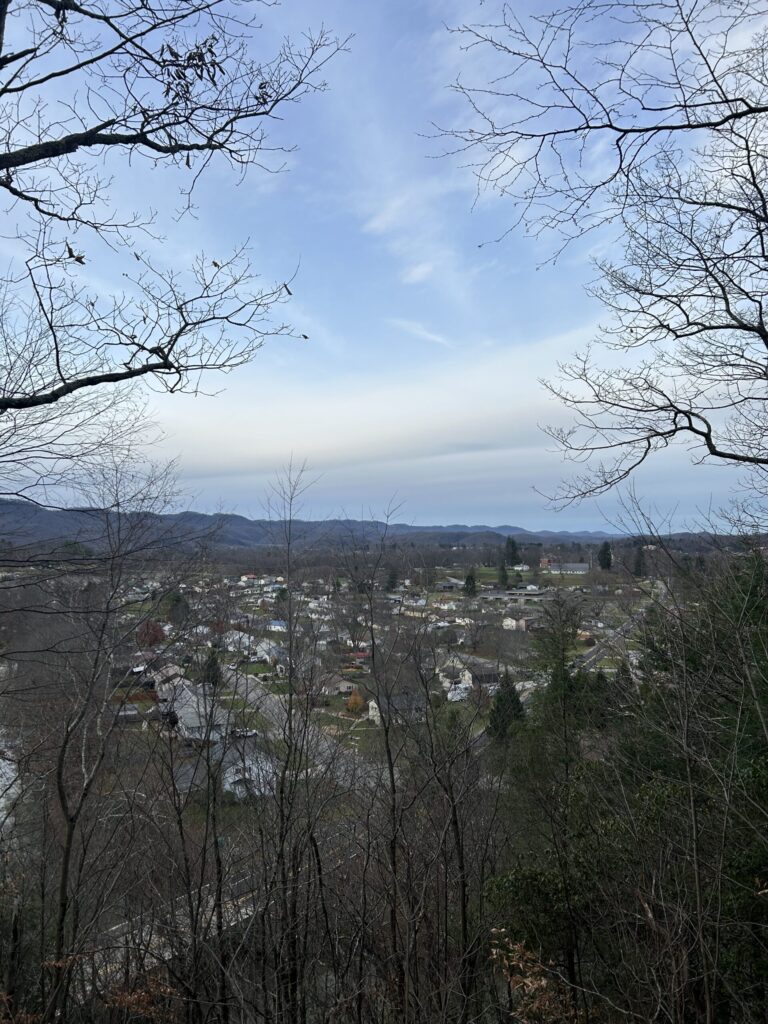
Cover Photo: Fig 1 Overlook Trail winds one hundred feet above the surrounding area along the Tygart Valley River. The hike is an easy to moderate level trail, perfect for a variety of ages! Photo credit: Marina Saviceva-Noti.
D&E Student Blog: This blog post was written by a D&E student, Marina Saviceva-Noti, in the ENGL 326: Writing for the Community course as a collaboration with Augusta.
I opened Google on my phone, searching for things to do on a boring spring Saturday. I was drifting around the satellite map when I saw a plot of forestland with some trails in it.
Fox Forest Wildlife Management Area lies just outside of downtown Elkins, West Virginia, and the area is an unassuming collection of moderate hiking trails and wilderness views. There’s something for every nature lover: a majestic overlook of Elkins via Overlook Trail, a forested vista through shrublands through Grassy Meadows Trail, an inviting joyride along the Pond Loop Trail, and exciting terrain with great reward via High Knob Trail. Along the way you’ll find maps guiding you through the area — the trails connect to one another, so you can always find a way out by staying on the path. Additionally, trees along each route are marked with colored paint to further guide you. It makes getting lost much less of a worry.
I have my God-given legs, and I set out one morning to use them. You’ll never catch me hiking alone, so my partner and I stepped down the D&E hill and through town, approaching Scott Ford Fishing Pier. There’s no indication of the trailhead until you walk just a bit further down Scotts Ford road — then you’ll see a sign and a trail map greeting you as you enter the woods.
The ground crunched underneath us as the air rushed into our lungs, the crisp mountain air invigorating us with excitement. While we had been talking amongst ourselves on the walk there, our conversation now dwindled to “did you hear that?” and “look at this!”
Between the rush of college, athletics, and in-general-life, the benefits of a nature retreat are matched by few other things. There’s something healing in the purity of the woods and its inhabitants. This year, I tapped into my inner birder, constantly observant of their songs, their flight, their striking colors and shapes. Take a walk, even down Davis Avenue, and you might be lucky enough to catch a house finch couple singing nearby.
In the Fox Forest area, don’t be startled by sparrows, woodpeckers, nuthatches, or thrushes (i.e., the American robin), who forage high and low among the trees and shrubs. In fact, you should download the Merlin app to help identify birds based on their calls or appearance. Sit down on a stump, open the app, and hit record as you watch the canopy for the slightest wing beat. Don’t forget that birds dwell in the old, bug-filled leaves around you, like the eastern towhee, who rustles the leaves for spiders and berries.
Our feet softly padded down the trail as dusk neared. The sounds of finding dinner swirled through the trees and down the valleys, filling the forest with pure life. It reminds me of the intricateness in each organism, the tinge of orange on a titmouse, the iridescence of grackles, the precise stripes of each of the New World sparrows that make it so hard to identify one from another.
We near the exit and head home, as do the birds.
Common native birds to see in Elkins:
- Song Sparrow (small brown and tan bird; listen for an unusual, piercing song on the edges of trees)
- Chipping Sparrow (small tan bird; listen for a rapid series of cheeps lasting between 3-5 seconds)
- House Finch (look for males with a distinct reddish-purple front perching on trees near buildings; listen for an elaborate song)
- American Robin (found on the ground and in trees, with a black back and a dark orange belly)
- Red-bellied Woodpecker (look on dead and dying trees for a medium-sized bird with a red head — he doesn’t have a red belly!)
- Red-winged Blackbird (males are black with orange patches on wings; listen for their distinct piercing call)
- Eastern Towhee (listen for one clear rising tone in forests, then look to the ground for movement)
- Tufted Titmouse (a small, greyish bird with quiet chirps often on trees)
- Killdeer (nests on the ground often near humans; listen for KILL-DEER flight calls later in the day)
- Northern Cardinal (males are bright red, females are brown with red tinges; most distinct call is a high-low whistle)
- White-breasted Nuthatch (blue-grey bird with a white belly, forages for insects on trees similar to woodpeckers)
- American Crow (medium-sized black bird with distinct CAW sound)
- Turkey Vulture (often soars high above the tree line; body is black and inner wings are tinted slightly with grey)
- Blue Jay (males are striking blue, females are grey with slight blue streaks; call is similar to woodpeckers’)
- Northern Mockingbird (fearless bird often perched above trees and houses; exceptional mimicry of birds, cars, or other sounds)
- Mourning Dove (listen for a low coo-oo; often seen perching on power lines and buildings)
D&E Student Bio: Marina Saviceva-Noti hails from just north of Tampa, Florida. She majors in Political Science and English at Davis & Elkins College while also playing on the golf team, and her love of hiking and the outdoors brought her to Wild and Wonderful West Virginia.
